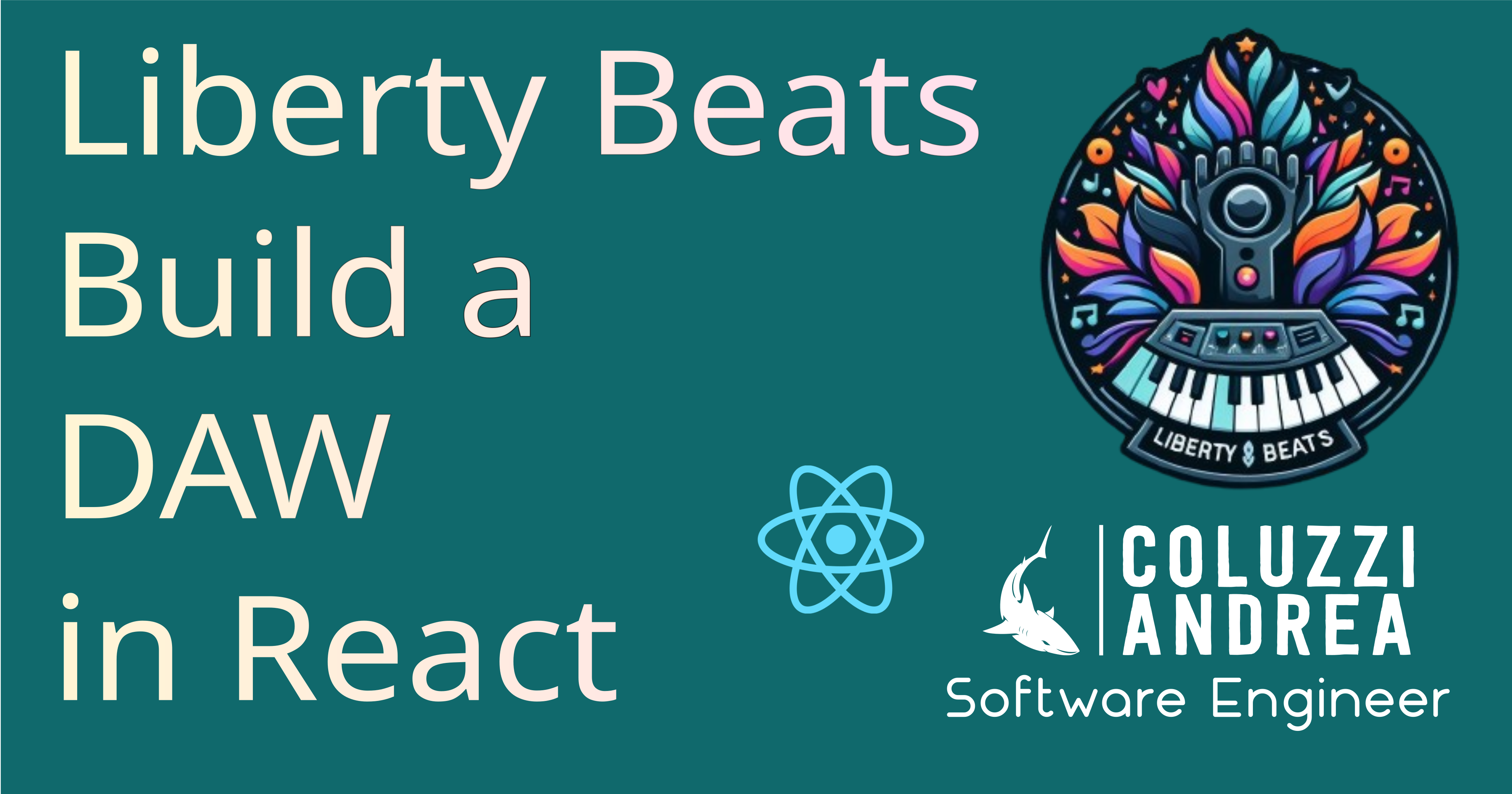Liberty Beats - Build a DAW in React
 Coluzzi Andrea
Coluzzi Andrea
Liberty Beats - Build a DAW in React
In this blog post, we will explore how to build a Digital Audio Workstation (DAW) in React. We will use the Tone.js library to create music and audio effects, and we will discuss the key components and features of a DAW application.

Introduction
A Digital Audio Workstation (DAW) is a software application used for recording, editing, and producing audio files. DAWs are commonly used by musicians, sound engineers, and producers to create music, podcasts, and other audio content.
In this tutorial, we will dive into the logic of Liberty Beats, a simple (but powerful) DAW application in React that allows users to create and edit music tracks.
The application is built using React components, state management, and the Tone.js library for audio synthesis and effects.
First Steps
Before we start building the DAW application, let's outline the key features and components that we want to include:
Track Editor: A visual interface for creating and editing music tracks. Users can add, remove, and modify audio clips, adjust volume and panning, and apply effects.
Transport Controls: Play, pause, stop, and seek controls for playback. Users can control the tempo from the panel.
Mixer: A mixer section for each track, where users can adjust volume, set solo and mute options.
Create a Vite React App and Set Up Tone.js
To get started, we will create a new React application using Vite, a fast build tool that supports React and modern JavaScript features.
Then, follow my previous blog post on how to integrate Tone.js in a React application to set up Tone.js in your project.
Create a store for the DAW
In Liberty Beats, we used Redux Toolkit to manage the application state. Redux Toolkit is a powerful library that simplifies the process of managing state in React applications.
Once you have set up Redux Toolkit in your project, you can create a store for the DAW application. The store will hold the state of the application, and the most important part is the playlist slice, which will contain the tracks and their settings.
Here's the type of the track object, taken from the Liberty Beats project:
export interface Track {
id: string
title: string
/**
* Tailwind CSS color class
* @example 'green'
*/
color: TrackColor
instrumentPreset: InstrumentPreset
/**
* Drums track specific data (can be undefined if track is not drums track)
*/
trackDrums?: TrackDrums
bars: Bar[]
volume: number
muted: boolean
soloed: boolean
areThereAnyOtherTrackSoloed: boolean
}
In the Track interface, we define the properties of a track:
id: A unique identifier for the track.title: The name of the track.color: A Tailwind CSS color class for the track (values set in theTrackColorenum).instrumentPreset: The instrument preset for the track, defined in theInstrumentPresetenum.trackDrums: Specific data for drums tracks (can beundefinedif the track is not a drums track). Drums need a different representation in the UI, and also different settings when it comes to the sequencer.bars: An array ofBarobjects, representing the bars in the track. EachBarobject contains the notes for each step in the bar.volume: The volume level of the track.muted: A boolean value indicating whether the track is muted.soloed: A boolean value indicating whether the track is soloed.areThereAnyOtherTrackSoloed: A boolean value indicating whether there are other tracks soloed in the playlist.
Building the Editor
Building the Editor is one of the most challenging parts of the DAW application. The Editor is a grid-based interface where users can create and edit music patterns by placing notes on a grid.
In Liberty Beats, we used a custom Editor component that allows users to create and edit music patterns for each track. The Editor component is built using React and Tone.js, and it provides a visual interface for creating and editing music patterns.

At the very beginning of the project, the Grid was made using a simple HTML table, but then I switched to a more performant solution using a canvas element. The canvas element allows for better performance and more flexibility when it comes to drawing the grid and the notes.
Here's a simplified version of the Editor component in Liberty Beats:
import React, { useEffect, useRef } from 'react'
import { Bar, Note } from '../types'
import { drawGrid, drawNotes } from '../utils/draw'
interface EditorProps {
bars: Bar[]
onNoteClick: (barIndex: number, stepIndex: number) => void
}
const Editor: React.FC<EditorProps> = ({ bars, onNoteClick }) => {
const canvasRef = useRef<HTMLCanvasElement>(null)
useEffect(() => {
if (canvasRef.current) {
const canvas = canvasRef.current
const ctx = canvas.getContext('2d')
if (ctx) {
drawGrid(ctx, bars)
drawNotes(ctx, bars)
}
}
}, [bars])
const handleClick = (event: React.MouseEvent<HTMLCanvasElement>) => {
const rect = event.currentTarget.getBoundingClientRect()
const x = event.clientX - rect.left
const y = event.clientY - rect.top
const stepIndex = Math.floor(x / 20)
const barIndex = Math.floor(y / 20)
onNoteClick(barIndex, stepIndex)
}
return (
<canvas
ref={canvasRef}
width={bars[0].notes.length * 20}
height={bars.length * 20}
onClick={handleClick}
/>
)
}
export default Editor
Implementing the Transport layer
The Transport layer is responsible for controlling the playback of the tracks in the DAW application. It provides controls for playing, pausing, stopping, and seeking the playback of the tracks.
In Liberty Beats, we used the Tone.Transport object from the Tone.js library to control the playback of the tracks. The Transport layer provides controls for starting, stopping, and seeking the playback of the tracks, as well as setting the tempo and time signature.
Using the store as a source of truth, we can easily control the playback of the tracks in the application. Here's a simplified version of the Transport component in Liberty Beats:
import React from 'react'
import { useDispatch, useSelector } from 'react-redux'
import { selectPlaylist, setPlaying } from '../store/playlistSlice'
const Transport: React.FC = () => {
const dispatch = useDispatch()
const playlist = useSelector(selectPlaylist)
const handlePlay = () => {
dispatch(setPlaying(true))
}
const handlePause = () => {
dispatch(setPlaying(false))
}
const handleStop = () => {
dispatch(setPlaying(false))
}
return (
<div>
<button onClick={handlePlay}>Play</button>
<button onClick={handlePause}>Pause</button>
<button onClick={handleStop}>Stop</button>
</div>
)
}
export default Transport
Conclusion
In this blog post, we explored how to build a Digital Audio Workstation (DAW) in React. We discussed the key components and features of a DAW application, including the Track Editor and Transport Control.
We used the Tone.js library to create music and audio effects, and we discussed how to manage the state of the application using Redux Toolkit.
Liberty Beats is a simple (but powerful) DAW application that allows users to create and edit music tracks. The application is built using React components, state management, and the Tone.js library for audio synthesis and effects.
You can find the full source code of the Liberty Beats project on GitHub: Liberty Beats
I hope you enjoyed this tutorial and found it helpful. If you have any questions or feedback, feel free to leave a comment below.
Happy coding!
Subscribe to my newsletter
Read articles from Coluzzi Andrea directly inside your inbox. Subscribe to the newsletter, and don't miss out.
Written by

Coluzzi Andrea
Coluzzi Andrea
👩💻 I'm Andrea, a Passionate Full Stack Software Engineer from 🇮🇹 Italy 💼 Building the best Gift Cards experience in Klarna since Feb 2023 🔥 In Jan 2023 I founded Latina In Tech, a local tech community based in Latina, Italy. We organize monthly tech events on various topics 🎸 I also play as guitarist for a rock band named Kezurya